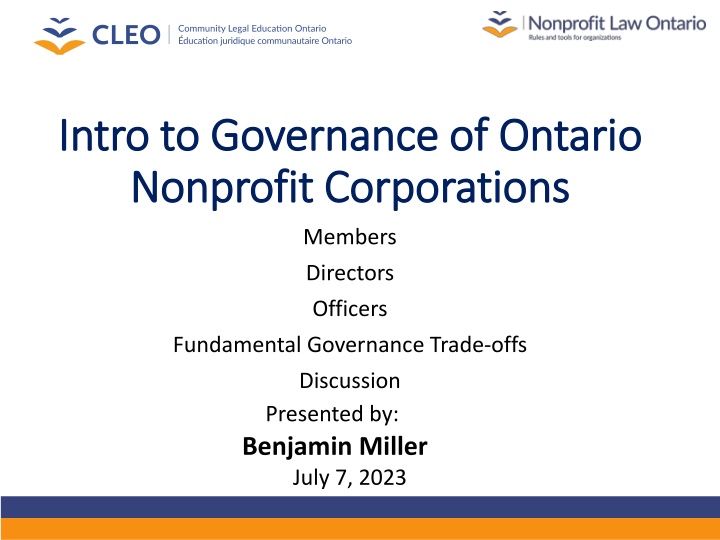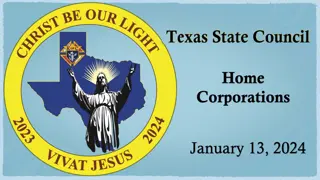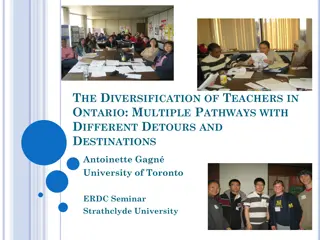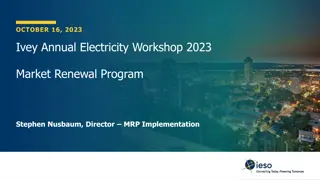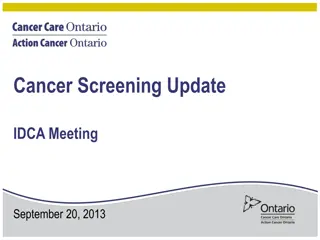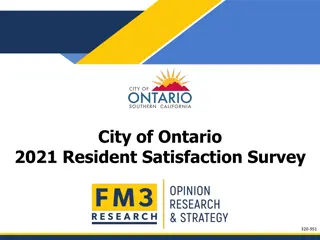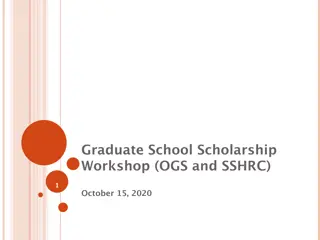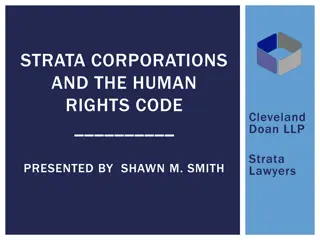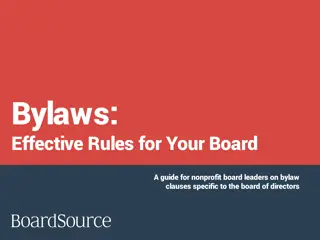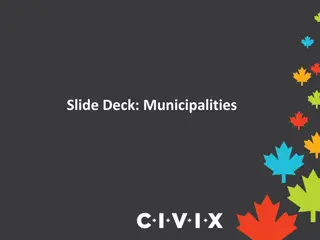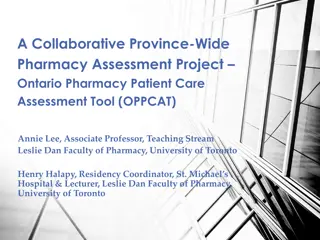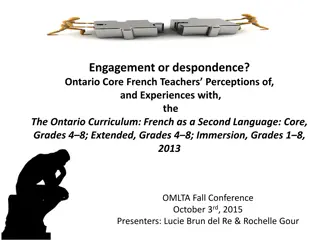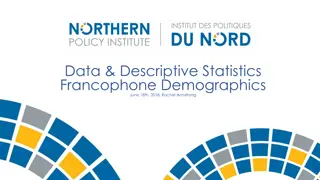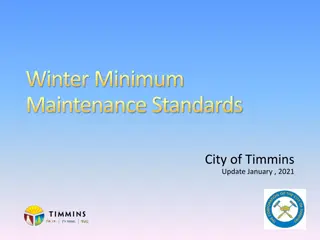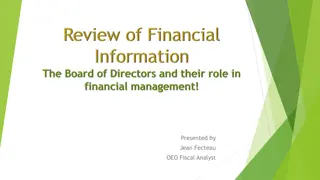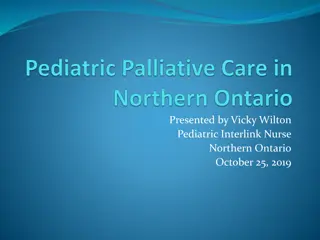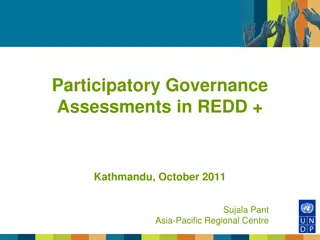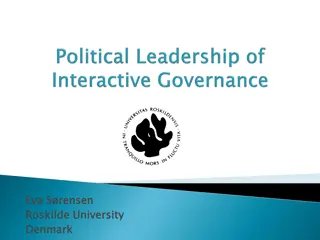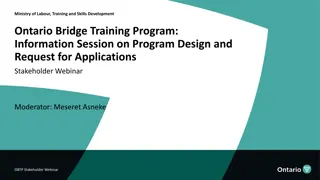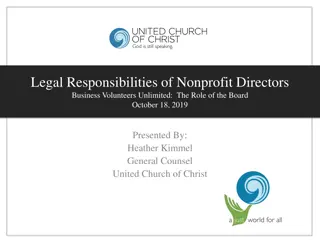Intro to Governance of Ontario Nonprofit Corporations.
Exploring the principles of governance in Ontario, this presentation covers topics such as nonprofit corporations, the Iroquois Confederacy's Great Law of Peace, formal and informal roles in corporate governance, the importance of law in governance, and more. Presented with visuals and a disclaimer emphasizing general legal information, it provides insights into fundamental governance concepts and trade-offs.
Download Presentation

Please find below an Image/Link to download the presentation.
The content on the website is provided AS IS for your information and personal use only. It may not be sold, licensed, or shared on other websites without obtaining consent from the author.If you encounter any issues during the download, it is possible that the publisher has removed the file from their server.
You are allowed to download the files provided on this website for personal or commercial use, subject to the condition that they are used lawfully. All files are the property of their respective owners.
The content on the website is provided AS IS for your information and personal use only. It may not be sold, licensed, or shared on other websites without obtaining consent from the author.
E N D
Presentation Transcript
Intro to Governance of Ontario Intro to Governance of Ontario Nonprofit Corporations Nonprofit Corporations Members Directors Officers Fundamental Governance Trade-offs Discussion Presented by: Benjamin Miller July 7, 2023
The Iroquois Confederacys Great Law of Peace The chiefs of the League of Five Nations shall be mentors of the people for all time. The thickness of their skins shall be seven spans, which is to say that they shall be proof against anger, offensive action and criticism. Their hearts shall be full of peace and good will and their minds filled with a yearning for the welfare of the people of the league. With endless patience, they shall carry out their duty. Their firmness shall be tempered with a tenderness for their people. Seneca, Cayuga, Oneida, Onondaga and Mohawk. Source: https://p12cdn4static.sharpschool.com/UserFiles/Servers/Server_520401/File/Departments/Curriculum%20&%20Instruction/ELA/Non- Fiction%20Texts/Iroquois%20Great%20Law%20of%20Peace.pdf 2
Housekeeping There will be a period for questions at the end of each section, but feel free to ask questions throughout by unmuting or typing in the chat. 3
Disclaimer This presentation is: general legal information it isn t legal advice tailored for your specific situation. a high-level overview of ONCA it isn t comprehensive and it doesn t address other areas of law, such as charity law. about law not psychology, management, or the many other things that go into governance. 4
Big Picture Formal Roles in Corporate Governance Members Control the organization elect the board Approve major decisions and changes to gov. docs Directors Oversee the management of the organization Appoint officers and agents Have legal duties to act in the best interest of the organization Officers Have powers delegated by the Board for a specific job Have legal duties to act in the best interests of the organization 5
Big Picture Informal Roles in Corporate Governance Employees Volunteers Beneficiaries local community Donors Funders Mentors Government 6
Laws Role in Governance Governance is fundamentally about relationships, so why care about law? Before relationships sour Creates clarity Opportunity to think through how things may go wrong After relationships sour Neutral arbiter Coercive remedies All the time Collective experience and wisdom 7
Members Members Member Rights Member Obligations Membership Models 8
Member Rights All members have the following rights: a free copy of your articles and bylaws view and get copies of your financial statements view and get member lists, You must have at least one class of voting members. Voting members have the following rights: Submit proposals Discuss any matter at a meeting Nominate a director (members controlling 5% vote) Demand a meeting be called (members controlling 10% vote) Elect or remove a director (50%+1 vote at a meeting) Notice of members meetings Approve changes to bylaws and other major decisions 9
Member Obligations Members are not subject to conflict of interest rules. Members that start acting like they are directors may unintentionally take on the duties of directors. 10
Model 1: Open Membership Anyone who supports your nonprofit s vision, mission, and values can become a voting member. Pros Cons more accountability more volunteers more revenue more privacy concerns More chance for conflict More work to keep track of 11
Model 2: Semi-Open Membership Not everyone can become a member because your bylaws can have conditions on membership. Examples of conditions: Who can be a member and how Requirements to stay a member Code of Conduct Maximum number of members Similar pros and cons to open membership. 12
Model 3: Self-Perpetuating Boards Directors don t have to be members, under ONCA. However, your bylaws can say that directors will be the only members. Pros Cons Less chance of conflict No legal way to get around directors duties Less work to inform and keep track of members No external accountability Risks less stakeholder participation Reputation for being closed 13
Model 4: Single Member The founding person or organization is your only member. Pros Cons Easy to manage Member retains total control Less transparent Risk of less stakeholder participation Reputation for closed 14
Model 5: Hybrid Membership Your directors are your only voting members, and a non-voting class is open to anyone who supports your nonprofit s work. Pros Cons More stakeholder participation Less accountability outside Board More work to keep track of 15
Model 6: Representative Membership Your directors make up one class of voting members. You also have one or more other voting classes made up of members who are elected by and represent different types of stakeholders for example, regional or youth stakeholders. Pros Cons More flexibility More transparency Less chance of mission drift Complicated to understand More work to keep track of 16
Directors Directors Directors Duties Directors Rights Board Models 17
Directors Duties ONCA s.43 states: (a) act honestly and in good faith with a view to the best interests of the corporation; and (b) exercise the care, diligence and skill that a reasonably prudent person would exercise in comparable circumstances. The Common Law adds: Duty of loyalty: Avoid and declare conflicts Duty of obedience: Once Board has voted must follow Duty of continuation: Must keep org going Duty of confidentiality: Cannot publicize board talk 18
Directors Rights Directors rights flow from what they need to be able to fulfill their duty. Notice and attendmeetings of board and members Access to all documents Voting (if voting directors) Raise issues and discuss matters Conflict of interest may limit rights. 19
Board Models Term Length: Default 1 year, max. 4 years, can rotate Number of terms: Default unlimited Number of directors: Min. 3 and can be a range Director qualifications: Member? Default no, but can be required Other: Wide flexibility to specify Election: Default all members elect all directors. A group or class can elect specific seats. Directors can be appointed by office (ex-officio) Voting: Can have non-voting directors, but same duties. Can be paid: Default yes, except for charities. 20
Officers Officers Rights, Duties, and Structures 21
Rights, Duties, and Structures Rights: Generally have the powers necessary to do their job Duties: Similar duties to directors Structure: Required chairperson who must be a director too, otherwise very flexible 22
Governance Trade Governance Trade- -Offs Offs Efficiency v Accountability Well Defined v Flexible Accessible v Complex 23
Efficiency v Accountability There is often a trade-off between being able to make decisions quickly and ensuring there are checks and balances. For example: Filling vacancies on the Board Voting thresholds Member discipline 24
Well Defined v Flexible You can define all procedures precisely in your bylaws or say that others will decide in future. For example: Officer duties Location of meeting Board committees 25
Accessible v Complex Making your governance more accessible often makes it more complicated to organize. For example: Online and phone meetings Proxy, electronic, and phone voting Multiple membership classes 26
Open Discussion Open Discussion 1)What issues are you facing with your employees and volunteers that you think may have a legal aspect to them? 2) Have others faced similar issues? How did you handle it? 3) Using Stepstojustice.ca
Questions? Questions? Benjamin.miller@cleo.on.ca https://nonprofitlaw.cleo.on.ca 28
